Household Energy and Water Practices Change Post-Occupancy in an Australian Low-Carbon Development
Abstract
1. Introduction
2. Social Practice Theory
3. Methods
3.1. Research Design
3.2. Project Participants
3.3. Mixed Methods
3.4. Data Analysis
4. Results and Discussion
4.1. Overall Change in Energy and Water Use at the Household Level
4.1.1. Energy Use
4.1.2. Water Use
4.2. Changes to Individual Practices and the Home System of Practice
4.2.1. Personal Hygiene Practices
4.2.2. Ambient Heating and Cooling Practices
4.2.3. Influence of Lifestyle and the HSOP on Cooling Practices
5. Research Insights and Conclusions
Author Contributions
Funding
Acknowledgments
Conflicts of Interest
Appendix A
| WGV Development | House | Pre-Occupancy Energy Data | Post-Occupancy Energy Data | Pre-Occupancy Water Data | Post-Occupancy Water Data |
|---|---|---|---|---|---|
| Evermore | A | NA | Spring and Summer | NA | Spring and Summer |
| B | 1 yr inc gas | Spring and Summer | 1 yr | Spring and Summer | |
| C | 1 yr inc gas | Spring and Summer | 1 yr | Spring and Summer | |
| I | NA | Spring and Summer | NA | Spring and Summer | |
| O | 1 yr inc gas | Spring and Summer | 1 yr | Spring and Summer | |
| SHAC | D | NA | 1 yr | Summer | 1 yr |
| H | 1 yr | 1 yr | Winter and Summer | 1 yr | |
| J | 1 yr | 1 yr | NA | 1 yr | |
| L | NA | Summer, Autumn, Winter | Spring, Summer, Autumn | Summer, Autumn, Winter | |
| N | Spring and Summer | 1 yr | Autumn | 1 yr | |
| Semi-Detached House | F | 1 yr inc gas | Summer | Summer and Autumn | Spring and Summer |
| M | NA | Summer | NA | Spring and Summer | |
| House | G | NA | Spring and Summer | 1 yr | February |
References
- BBC News UN Chief Makes Antarctica Visit. Available online: http://news.bbc.co.uk/go/pr/fr/-/2/hi/science/nature/7088435.stm (accessed on 22 July 2019).
- United Nations Sustainable Development Goals. Available online: https://sustainabledevelopment.un.org/ (accessed on 22 July 2019).
- Water Corporation. Perth Residential Water Use Study 2008/2009; Water Corporation: Perth, Australia, 2010. [Google Scholar]
- DEWHA. Energy Use in the Australian Residential Sector 1986–2020; Australian Government: Canberra, Australia, 2008.
- Azevedo, I.M.L. Consumer End-Use Energy Efficiency and Rebound Effects. Annu. Rev. Environ. Resour. 2014, 39, 393–418. [Google Scholar] [CrossRef]
- Buhl, J.; von Geibler, J.; Echternacht, L.; Linder, M. Rebound effects in Living Labs: Opportunities for monitoring and mitigating re-spending and time use effects in user integrated innovation design. J. Clean. Prod. 2017, 151, 592–602. [Google Scholar] [CrossRef]
- Watson, K.J. Understanding the role of building management in the low-energy performance of passive sustainable design: Practices of natural ventilation in a UK office building. Indoor Built Environ. 2015, 24, 999–1009. [Google Scholar] [CrossRef]
- Berry, S.; Davidson, K. Zero energy homes—Are they economically viable? Energy Policy 2015, 85, 12–21. [Google Scholar] [CrossRef]
- Berry, S.; Moore, T.; Sherriff, G.; Whaley, D. Low-Energy Housing: Are We Asking the Right Questions? In Proceedings of the 10th International Conference in Sustainability of Energy and Buildings (SEB’18); Kaparaju, P., Howlett, R.J., Littlewood, J.R., Ekanyake, C., Vlacic, L., Eds.; Springer: Cham, Switzerland, 2019; pp. 445–452. [Google Scholar]
- Sherriff, G.; Moore, T.; Berry, S.; Ambrose, A.; Goodchild, B.; Maye-banbury, A. Coping with extremes, creating comfort: User experiences of ‘ low-energy ’ homes in Australia. Energy Res. Soc. Sci. 2019, 51, 44–54. [Google Scholar] [CrossRef]
- Whaley, D.; Berry, S.; Moore, T.; Sherriff, G.; O’Leary, T. Resident’s Issues and Interactions with Grid-Connected Photovoltaic Energy System in High-Performing Low-Energy Dwellings: A User’s Perspective. In Proceedings of the 10th International Conference in Sustainability of Energy and Buildings (SEB’18); Kaparaju, P., Howlett, R.J., Littlewood, J.R., Ekanyaka, C., Vlacic, L., Eds.; Springer: Cham, Switzerland, 2019; pp. 413–424. [Google Scholar]
- Berry, S.; Whaley, D.; Davidson, K.; Saman, W. Near zero energy homes—What do users think? Energy Policy 2014, 73, 127–137. [Google Scholar] [CrossRef]
- Meir, I.A.; Garb, Y.; Jiao, D.; Cicelsky, A. Post-occupancy evaluation: An inevitable step toward sustainability. Adv. Build. Energy Res. 2009, 3, 189–219. [Google Scholar] [CrossRef]
- Hampton, S. An ethnography of energy demand and working from home: Exploring the affective dimensions of social practice in the United Kingdom. Energy Res. Soc. Sci. 2017, 28, 1–10. [Google Scholar] [CrossRef]
- Torriti, J. Understanding the timing of energy demand through time use data: Time of the day dependence of social practices and energy demand. Energy Res. Soc. Sci. 2017, 25, 37–47. [Google Scholar] [CrossRef]
- Wittenberg, I.; Matthies, E. Solar policy and practice in Germany: How do residential households with solar panels use electricity? Energy Res. Soc. Sci. 2016, 21, 199–211. [Google Scholar] [CrossRef]
- Nicholls, L.; Strengers, Y. Peak demand and the “family peak” period in Australia: Understanding practice (in)flexibility in households with children. Energy Res. Soc. Sci. 2015, 9, 116–124. [Google Scholar] [CrossRef]
- Van Der Grijp, N.; Van Der Woerd, F.; Gaiddon, B.; Hummelshøj, R.; Larsson, M.; Osunmuyiwa, O.; Rooth, R. Demonstration projects of Nearly Zero Energy Buildings: Lessons from end- user experiences in Amsterdam, Helsingborg, and Lyon. Energy Res. Soc. Sci. 2019, 49, 10–15. [Google Scholar] [CrossRef]
- Strengers, Y.; Nicholls, L. Convenience and energy consumption in the smart home of the future: Industry visions from Australia and beyond. Energy Res. Soc. Sci. 2017, 32, 86–93. [Google Scholar] [CrossRef]
- Maréchal, K.; Holzemer, L. Getting a (sustainable) grip on energy consumption: The importance of household dynamics and “habitual practices”. Energy Res. Soc. Sci. 2015, 10, 228–239. [Google Scholar]
- Walker, G. The dynamics of energy demand: Change, rhythm and synchronicity. Energy Res. Soc. Sci. 2014, 1, 49–55. [Google Scholar] [CrossRef]
- Hess, A.K.; Samuel, R.; Burger, P. Informing a social practice theory framework with social-psychological factors for analyzing routinized energy consumption: A multivariate analysis of three practices. Energy Res. Soc. Sci. 2018, 46, 183–193. [Google Scholar] [CrossRef]
- Ambrose, A.; Goodchild, B.; O’Flaherty, F. Understanding the user in low energy housing: A comparison of positivist and phenomenological approaches. Energy Res. Soc. Sci. 2017, 34, 163–171. [Google Scholar] [CrossRef]
- Friis, F.; Haunstrup Christensen, T. The challenge of time shifting energy demand practices: Insights from Denmark. Energy Res. Soc. Sci. 2016, 19, 124–133. [Google Scholar] [CrossRef]
- Stern, P.C. Individual and household interactions with energy systems: Toward integrated understanding. Energy Res. Soc. Sci. 2014, 1, 41–48. [Google Scholar] [CrossRef]
- Gram-Hanssen, K. New needs for better understanding of household’s energy consumption- behaviour, lifestyle or practices? Archit. Eng. Des. Manag. 2014, 10, 91–107. [Google Scholar] [CrossRef]
- Sunikka-Blank, M.; Galvin, R. Introducing the prebound effect: The gap between performance and actual energy consumption. Build. Res. Inf. 2012, 40, 260–273. [Google Scholar] [CrossRef]
- Yu, B.Y.; Zhang, J.Y.; Fujiwara, A. Rebound effects caused by the improvement of vehicle energy efficiency: An analysis based on a SP-off-RP survey. Transp. Res. Part D-Transport Environ. 2013, 24, 62–68. [Google Scholar] [CrossRef]
- Gram-Hanssen, K. Efficient technologies or user behaviour, which is the more important when reducing households’ energy consumption? Energy Effic. 2013, 6, 447–457. [Google Scholar] [CrossRef]
- Gram-Hanssen, K. Standby consumption in households analyzed with a practice theory approach. J. Ind. Ecol. 2010, 14, 150–165. [Google Scholar] [CrossRef]
- Australian Government Heating and Cooling. Available online: http://www.yourhome.gov.au/energy/heating-and-cooling (accessed on 22 July 2019).
- Schatzki, T. Social Practices: A Wittgensteinian Approach to Human Activity and the Social; Cambridge University Press: New York, NY, USA, 1996. [Google Scholar]
- Reckwitz, A. Towards a Theory of Social Practices: A Development in Culturalist Theorizing. Eur. J. Soc. Theory 2002, 5, 243–263. [Google Scholar] [CrossRef]
- Shove, E. Comfort, Cleanliness and Convenience; Berg Publisher: Oxford, UK, 2003. [Google Scholar]
- Warde, A. Consumption and Theories of Practice. J. Consum. Cult. 2005, 5, 131–153. [Google Scholar] [CrossRef]
- Røpke, I. New technology in everyday life: Social processes and environmental impact. Ecol. Econ. 2001, 38, 403–422. [Google Scholar] [CrossRef]
- Shove, E.; Chappells, H.; Lutzenhiser, L. Comfort in a Lower Carbon Society; Routledge: London, UK; New York, NY, USA, 2010. [Google Scholar]
- Eon, C.; Breadsell, J.K.; Morrison, G.M.; Byrne, J. The home as a system of practice and its implications for energy and water metabolism. Sustain. Prod. Consum. 2018, 13, 48–59. [Google Scholar] [CrossRef]
- Shove, E.; Pantzar, M.; Watson, M. The Dynamics of Social Practice: Everyday Life and How It Changes; SAGE Publications: London, UK, 2012. [Google Scholar]
- Macrorie, R.; Foulds, C.; Hargreaves, T. Governing and Governed by Practices: Exploring interventions in low-carbon housing policy and practice. In Social Practices, Intervention and Sustainability: Beyond Behaviour Change; Strengers, Y., Maller, C., Eds.; Routledge: Oxford, UK; New York, NY, USA, 2015; pp. 95–111. [Google Scholar]
- Watson, M. How theories of practice can inform transition to a decarbonised transport system. J. Transp. Geogr. 2012, 24, 488–496. [Google Scholar] [CrossRef]
- Spurling, N.; Mcmeekin, A.; Shove, E.; Southerton, D.; Welch, D. Interventions in Practice: Re-Framing Policy Approaches to Consumer Behaviour; Sustainable Practices Research Group: Swindon, UK, 2013. [Google Scholar]
- Breadsell, J.; Eon, C.; Morrison, G.M.; Kashima, Y. Interlocking practices and their influence in the home. Environ. Plan. B Urban Anal. City Sci. 2019, 46, 1405–1421. [Google Scholar] [CrossRef]
- Eon, C.; Liu, X.; Morrison, G.M.; Byrne, J. Influencing energy and water use within a home system of practice. Energy Build. 2018, 158, 848–860. [Google Scholar] [CrossRef]
- Smale, R.; van Vliet, B.; Spaargaren, G. When social practices meet smart grids: Flexibility, grid management, and domestic consumption in The Netherlands. Energy Res. Soc. Sci. 2017, 34, 132–140. [Google Scholar] [CrossRef]
- Anderson, B. Laundry, energy and time: Insights from 20 years of time-use diary data in the United Kingdom. Energy Res. Soc. Sci. 2016, 22, 125–136. [Google Scholar] [CrossRef]
- Spurling, N.; McMeekin, A. Interventions in Practices: Sustainable mobility policies in England. In Social Practices, Intervention and Sustainability: Beyond Behaviour Change; Strengers, Y., Maller, C., Eds.; Routledge: Oxford, UK; New York, NY, USA, 2015; pp. 78–94. [Google Scholar]
- Mlecnik, E.; Schütze, T.; Jansen, S.J.T.; De Vries, G.; Visscher, H.J.; Van Hal, A. End-user experiences in nearly zero-energy houses. Energy Build. 2012, 49, 471–478. [Google Scholar] [CrossRef]
- Moore, T.; Ridley, I.; Strengers, Y.; Maller, C.; Horne, R. Dwelling performance and adaptive summer comfort in low-income Australian households. Build. Res. Inf. 2017, 45, 443–456. [Google Scholar] [CrossRef]
- Department of the Environment and Energy Nationwide House Energy Rating Scheme (NatHERS). Administrative and Governance Arrangements; Australian Government: Canberra, Australia, 2015.
- Bureau of Meteorology Climate Statistics for Australian Locations. Available online: http://www.bom.gov.au/climate/averages/tables/cw_009083.shtml (accessed on 27 June 2019).
- Water Corporation Groundwater. Available online: https://www.watercorporation.com.au/water-supply/our-water-sources/groundwater (accessed on 4 July 2019).
- Water Corporation Our Water Sources. Available online: https://www.watercorporation.com.au/water-supply/our-water-sources (accessed on 2 July 2019).
- Byrne, J.; Green, M.; Dallas, S. WSUD Implementation in a Precinct Residential Development: Perth Case Study. In Approaches to Water Sensitive Urban Design: Potential, Design, Ecological Health, Urban Greening, Economics, Policies and Community Perceptions; Sharma, A.K., Gardner, T., Begbie, D., Eds.; Elsevier: Amsterdam, The Netherlands, 2019; pp. 541–559. [Google Scholar]
- Wiktorowicz, J.; Babaeff, T.; Breadsell, J.; Byrne, J.; Eggleston, J.; Newman, P. WGV: An Australian Urban Precinct Case Study to Demonstrate the 1.5C Agenda including Multiple SDGs. Urban Plan. 2018, 3, 64–81. [Google Scholar] [CrossRef]
- Liedtke, C.; Baedeker, C.; Hasselkuß, M.; Rohn, H.; Grinewitschus, V. User-integrated innovation in Sustainable LivingLabs: An experimental infrastructure for researching and developing sustainable product service systems. J. Clean. Prod. 2015, 97, 106–116. [Google Scholar] [CrossRef]
- Browne, A.; Meed, W.; Anderson, B.; Pullinger, M. Method as intervention: Intervening in practice through quantitative and mixed methodologies. In Social Practices, Intervention and Sustainability: Beyond Behaviour Change; Strengers, Y., Maller, C., Eds.; Routledge: Oxford, UK; New York, NY, USA, 2015; pp. 179–195. [Google Scholar]
- Romero, N.; Al Mahmud, A.; Beella, S.; Keyson, D.V. Towards an Integrated Methodology to Design Sustainable Living Practices. In Proceedings of the Ambient Intelligence: 4th International Joint Conference, AmI 2013, Dublin, Ireland, 3–5 December 2013; Augusto, J.C., Wichert, R., Collier, R., Keyson, D., Salah, A.A., Tan, A.-H., Eds.; Springer International Publishing: Cham, Switzerland, 2013; pp. 299–304. [Google Scholar]
- Hollstein, B. Qualitative Approaches. In The SAGE Handbook of Social Network Analysis; Scott, J., Carrington, P., Eds.; SAGE Publications: London, UK, 2011; pp. 404–416. [Google Scholar]
- Sanders, E.B.N.; Stappers, P.J. Probes, toolkits and prototypes: Three approaches to making in codesigning. CoDesign 2014, 10, 5–14. [Google Scholar] [CrossRef]
- Gaver, B.; Dunne, T.; Pacenti, E. Design: Cultural Probes. Interactions 1999, 6, 21–29. [Google Scholar] [CrossRef]
- Thoring, K.; Luippold, C.; Mueller, R.M. Opening the Cultural Probes Box: A Critical Reflection and Analysis of the Cultural Probes Method. In Proceedings of the 5th International Congress of International Association of Societies of Design Research, Tokyo, Japan, 26–30 August 2013; pp. 222–233. [Google Scholar]
- Australian Energy Market Commission. 2017 Residential Electricity Price Trends: Report 2017; Australian Energy Market Commission: Sydney, Australia, 2017.
- Living Smart Participant Handbook. Available online: https://www.livingsmart.org.au/wp-content/uploads/2013/08/ParticipantHandbook-LivingSmart-SinglePages1.pdf (accessed on 14 August 2019).
- Rathnayaka, K.; Malano, H.; Maheepala, S.; George, B.; Nawarathna, B.; Arora, M.; Roberts, P. Seasonal Demand Dynamics of Residential Water End-Uses. Water 2015, 7, 202–216. [Google Scholar] [CrossRef]
- Pink, S.; Mackley, K.L. Social science, design and everyday life: Refiguring showering through anthropological ethnography. J. Des. Res. 2015, 13, 278–292. [Google Scholar] [CrossRef]
- Hand, M.; Shove, E.; Southerton, D. Explaining Showering: A Discussion of the Material, Conventional, and Temporal Dimensions of Practice. Sociol. Res. Online 2005, 10, 1–13. [Google Scholar] [CrossRef]
- Kuijer, L.; De Jong, A.; van Eijk, D. Practices as a Unit of Design: An Exploration of Theoretical Guidelines in a Study on Bathing. ACM Trans. Comput. Interact. 2013, 20, 21. [Google Scholar] [CrossRef]
- O’Brien, L.V.; Meis, J.; Anderson, R.C.; Rizio, S.M.; Ambrose, M.; Bruce, G.; Critchley, C.R.; Dudgeon, P.; Newton, P.; Robins, G.; et al. Low Carbon Readiness Index: A short measure to predict private low carbon behaviour. J. Environ. Psychol. 2018, 57, 34–44. [Google Scholar] [CrossRef]
- NatHERS National Administrator. Nationwide House Energy Rating Scheme (NatHERS)—Software Accreditation Protocol; Department of Environment and Energy: Canberra, Australia, 2012.
- Nesticò, A.; Sica, F. The sustainability of urban renewal projects: A model for economic multi-criteria analysis. J. Prop. Investig. Financ. 2017, 35, 397–409. [Google Scholar] [CrossRef]
- Nesticò, A.; Guarini, M.R.; Morano, P.; Sica, F. An economic analysis algorithm for urban forestry projects. Sustainability 2019, 11, 314. [Google Scholar] [CrossRef]
- Boldero, J.M.; Binder, G. Can psychological and practice theory approaches to environmental sustainability be integrated? Environ. Plan. A 2013, 45, 2535–2538. [Google Scholar] [CrossRef]
- Binder, G. Theory(izing)/practice: The model of recursive cultural adaptation. Plan. Theory 2012, 11, 221–241. [Google Scholar] [CrossRef]
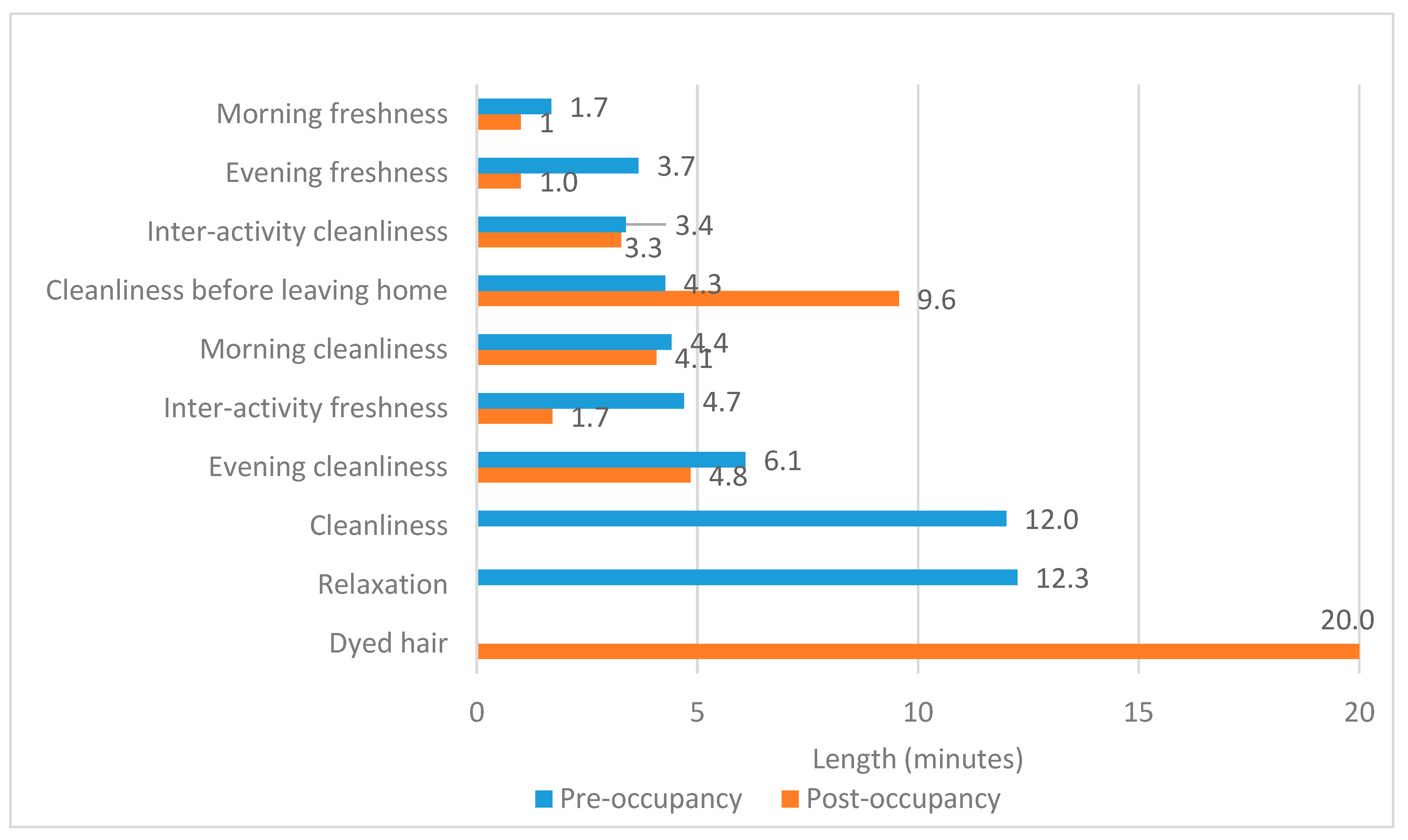
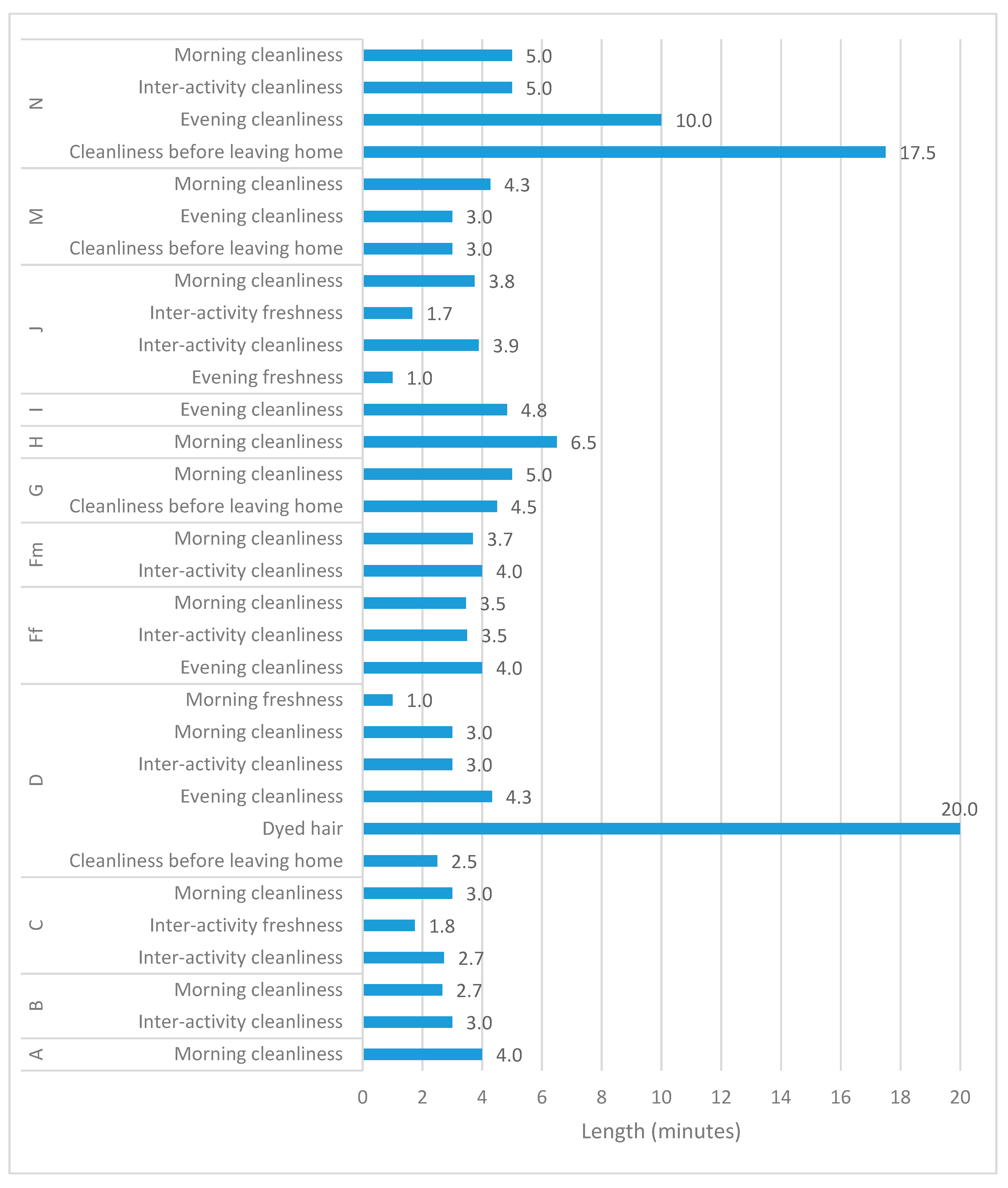
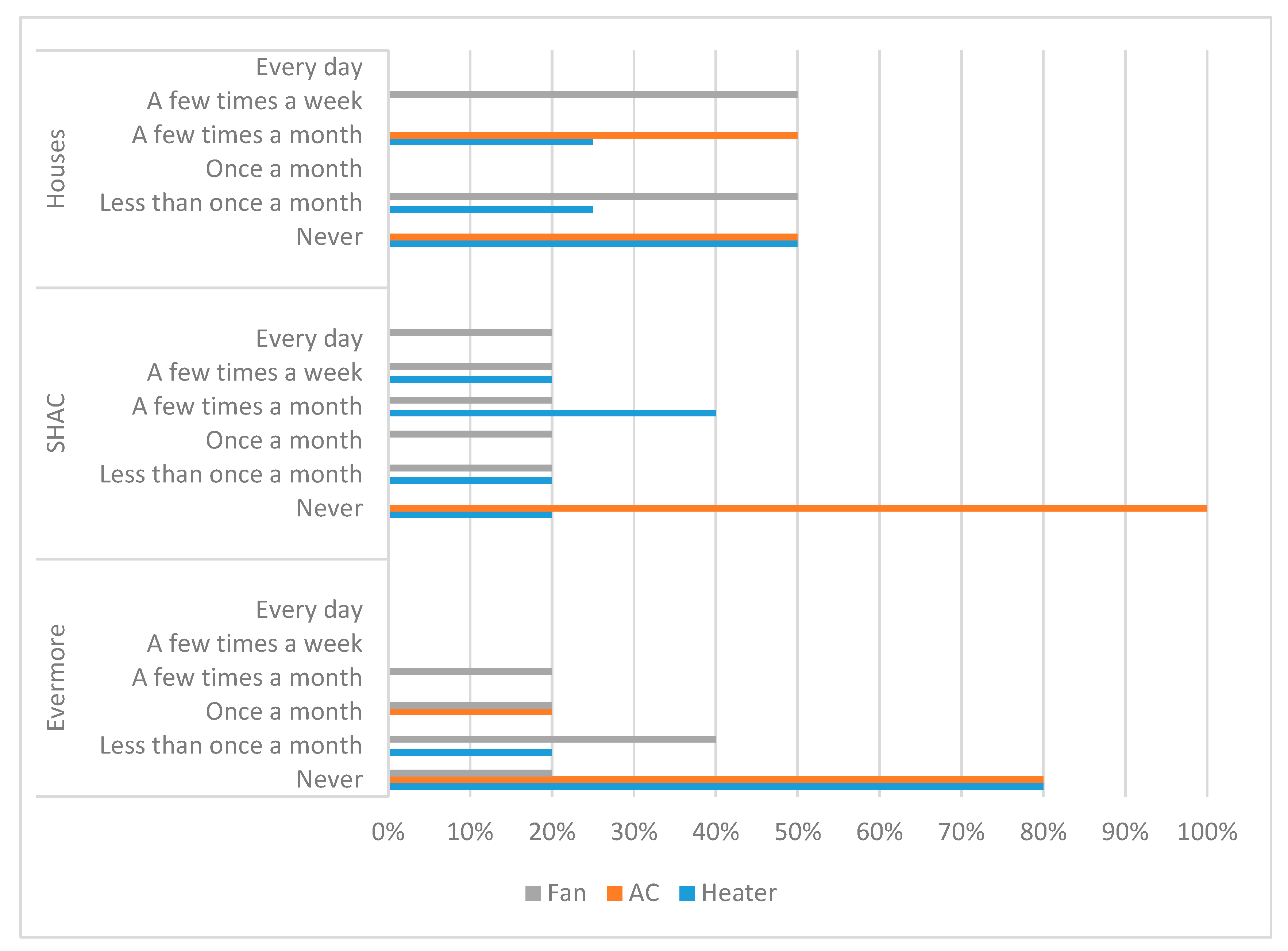
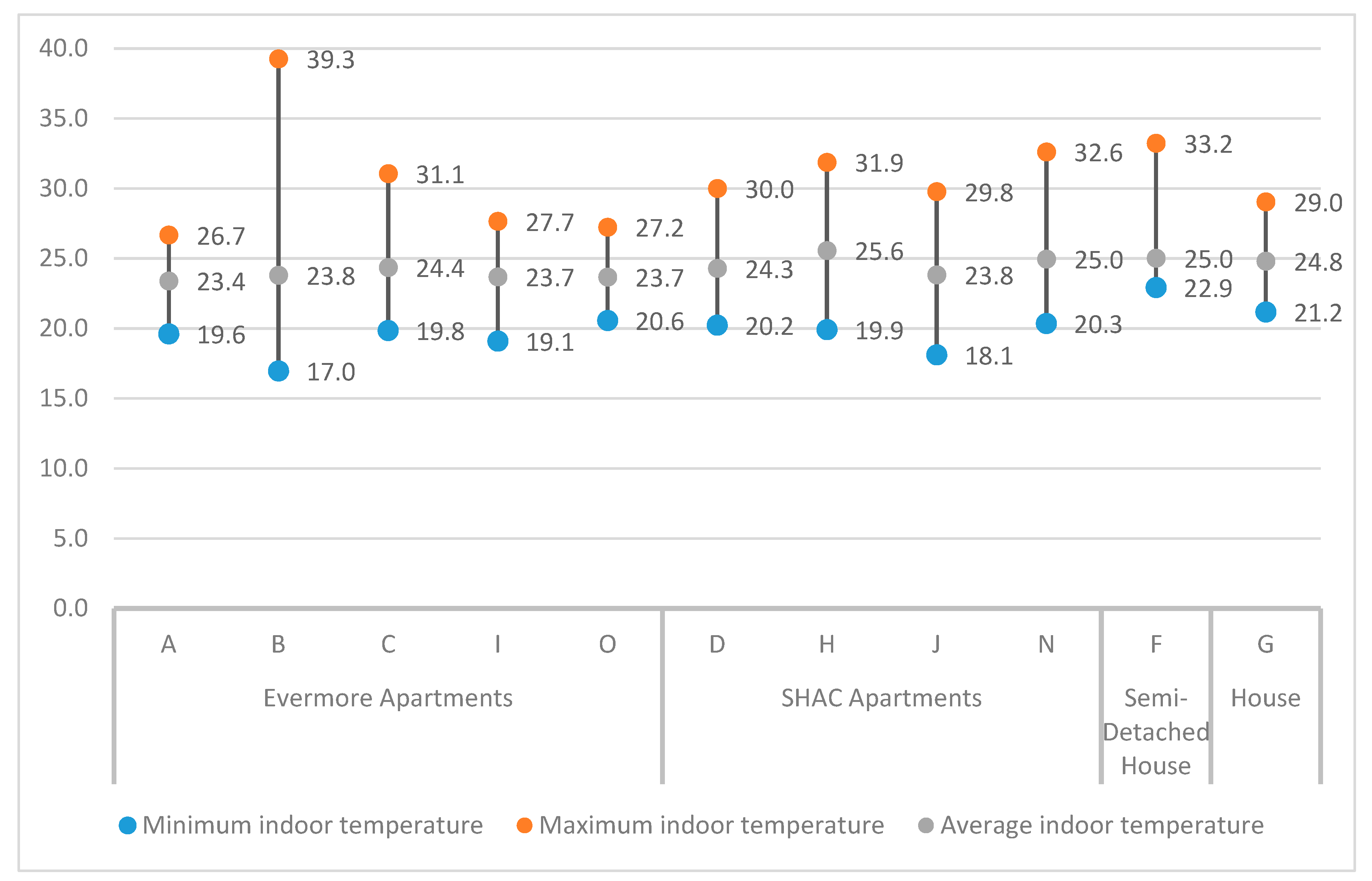
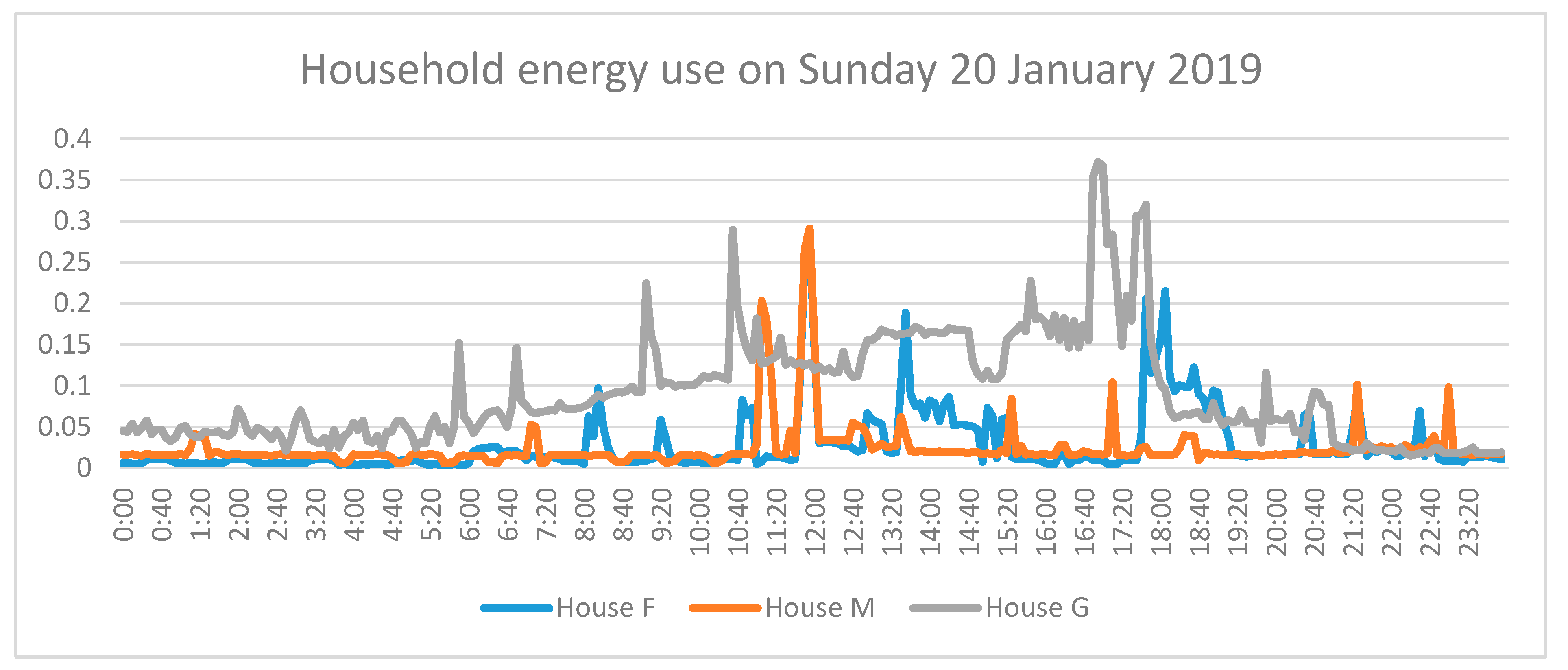

| Dwelling | House | Occupancy Lifestyle |
|---|---|---|
| Evermore Apartments | A | Works full-time off-site |
| B | Works 4 days a week off-site; daughter is a student who is at home most days | |
| C | Works 4 days a week off-site | |
| I | Retiree | |
| O | Works full-time off-site; son is a student who is at home most days | |
| Sustainable Housing for Artists and Creatives (SHAC) Apartments | D | Works part-time off-site, part-time on site; son works part-time off site |
| H | Works part-time off-site, part-time on-site | |
| J | Works part-time off-site | |
| L | Works part-time off-site, part-time on-site; has a 5-year-old who is a part-time school student | |
| N | Works part-time on-site | |
| Semi-Detached House | F | Both residents work full-time off-site |
| Semi-Detached House | M | Both residents work full-time off-site |
| Detached House | G | Shift work full-time off-site; daughter is a student who is at home most days |
| WGV Development | House | Pre-Occupancy Energy/Household/Day (kWh) | Post-Occupancy Energy/Household/Day (kWh) | Change Normalised to Metro Average |
|---|---|---|---|---|
| Evermore Apartments | A | NA | 4.44 | NA |
| B | 5.54 | 6.61 | −0.05 | |
| C | 29.25 | 7.02 | 1.11 | |
| I | NA | 5.90 | NA | |
| O | 5.54 | 5.88 | −0.02 | |
| SHAC Apartments | D | NA | 14.08 | 0.45 |
| H | 7.37 | 9.46 | −0.10 | |
| J | 7.21 | 8.52 | −0.07 | |
| L | NA | 6.79 | NA | |
| N | 21.16 | 5.67 | 0.77 | |
| Semi-Detached House | F | 11.93 | 6.72 | 0.26 |
| House | G | NA | 12.30 | NA |
| Semi-Detached House | M | NA | 4.88 | NA |
| WGV Development | House | Pre-Occupancy Water Use/Household/Day (L) | Post-Occupancy Water/Household/Day (L) | Change Normalised to Metro Average |
|---|---|---|---|---|
| Evermore Apartments | A | NA | 131.40 | NA |
| B | 210.01 | 233.48 | −0.04 | |
| C | 409.65 | 133.35 | 0.44 | |
| I | NA | 114.78 | NA | |
| O | 210.01 | 109.51 | 0.16 | |
| SHAC Apartments | D | 2186.44 | 371.90 | 2.92 |
| H | 817.21 | 516.00 | 0.48 | |
| J | NA | 657.39 | NA | |
| L | 1873.26 | 110.14 | 2.83 | |
| N | 508.47 | 230.59 | 0.45 | |
| Semi-Detached House | F | 295.85 | 359.53 | −0.10 |
| House | G | 959.39 | 511.95 | 0.72 |
| Semi-Detached House | M | NA | 359.53 | NA |
| WGV Development | House | Pre-Occupancy Heating | WGV Heating | Pre-Occupancy Cooling | WGV Cooling |
|---|---|---|---|---|---|
| Evermore Apartments | A | Gas heater | RC AC | AC | Standing fans, RC AC |
| B | Heater, Oven | None | Fans, RC AC | Ceiling fans | |
| C | Gas heater | RC AC | Fans | Ceiling fans, RC AC | |
| I | Oven | RC AC | Fans, RC AC | RC AC | |
| O | Heater, Oven | None | Fans, RC AC | Ceiling fans | |
| SHAC Apartments | D | Wood stove, RC AC | None | RC AC, fans | Fans |
| H | Electric oil heater | Electric oil heater | Fans | Fans | |
| J | Electric oil heater | Electric oil heater | Fans | Fans | |
| L | Fire, Electric oil heater | Electric oil heater | Evaporative AC, fans | Fans | |
| N | Electric oil heater | Electric oil heater | Fans, RC AC | Fans | |
| Semi-Detached House | F | Electric heater | Underfloor hydraulic heating | Fans | RC AC, Fans |
| House | G | Electric heater | RC AC | Fans, AC | RC AC, Fans |
| Semi-Detached House | M | None | Underfloor hydraulic heating | Fans | Fans, RC AC |
© 2019 by the authors. Licensee MDPI, Basel, Switzerland. This article is an open access article distributed under the terms and conditions of the Creative Commons Attribution (CC BY) license (http://creativecommons.org/licenses/by/4.0/).
Share and Cite
Breadsell, J.K.; Byrne, J.J.; Morrison, G.M. Household Energy and Water Practices Change Post-Occupancy in an Australian Low-Carbon Development. Sustainability 2019, 11, 5559. https://doi.org/10.3390/su11205559
Breadsell JK, Byrne JJ, Morrison GM. Household Energy and Water Practices Change Post-Occupancy in an Australian Low-Carbon Development. Sustainability. 2019; 11(20):5559. https://doi.org/10.3390/su11205559
Chicago/Turabian StyleBreadsell, Jessica K., Joshua J. Byrne, and Gregory M. Morrison. 2019. "Household Energy and Water Practices Change Post-Occupancy in an Australian Low-Carbon Development" Sustainability 11, no. 20: 5559. https://doi.org/10.3390/su11205559
APA StyleBreadsell, J. K., Byrne, J. J., & Morrison, G. M. (2019). Household Energy and Water Practices Change Post-Occupancy in an Australian Low-Carbon Development. Sustainability, 11(20), 5559. https://doi.org/10.3390/su11205559







